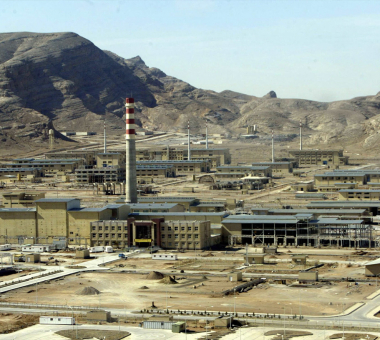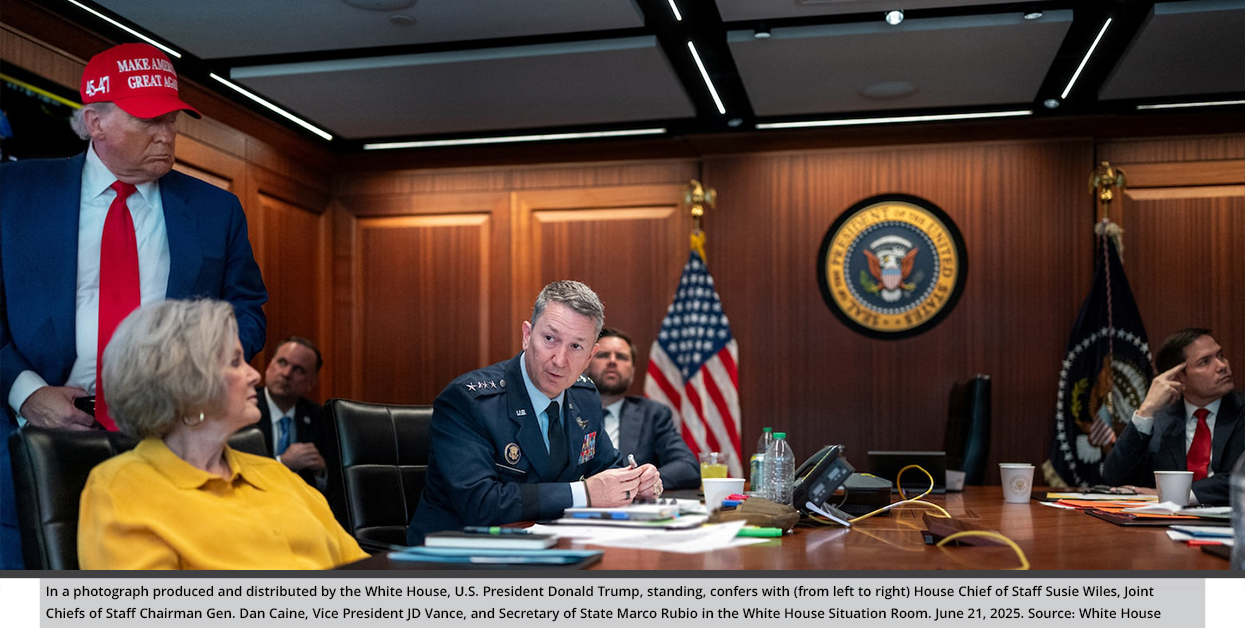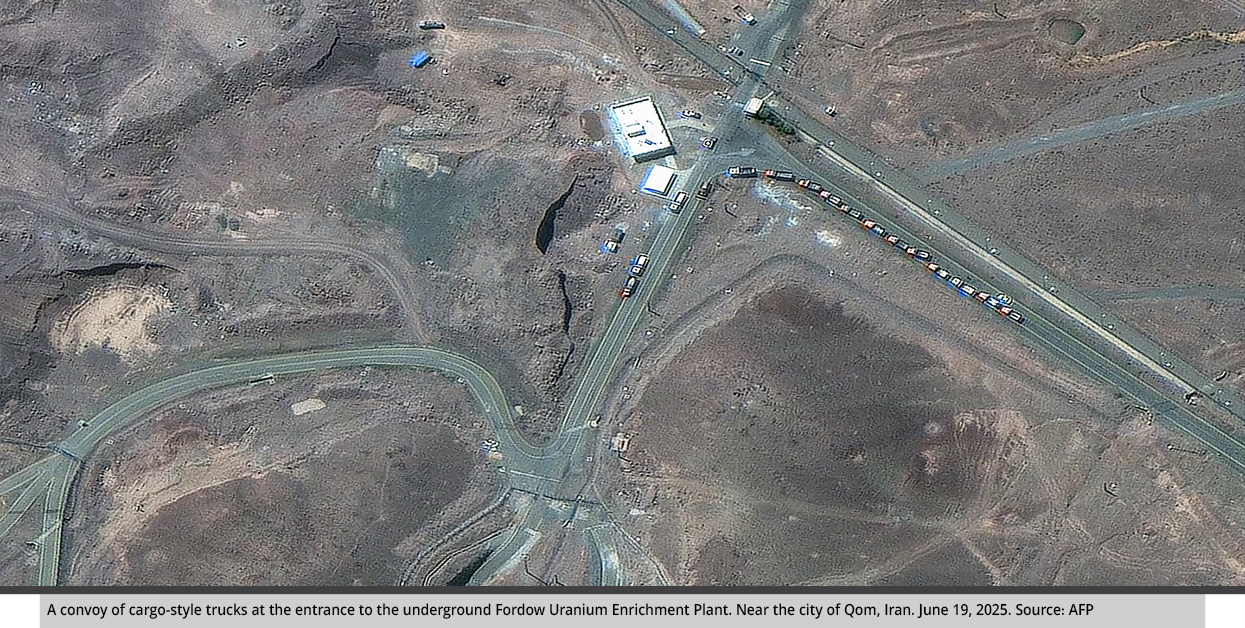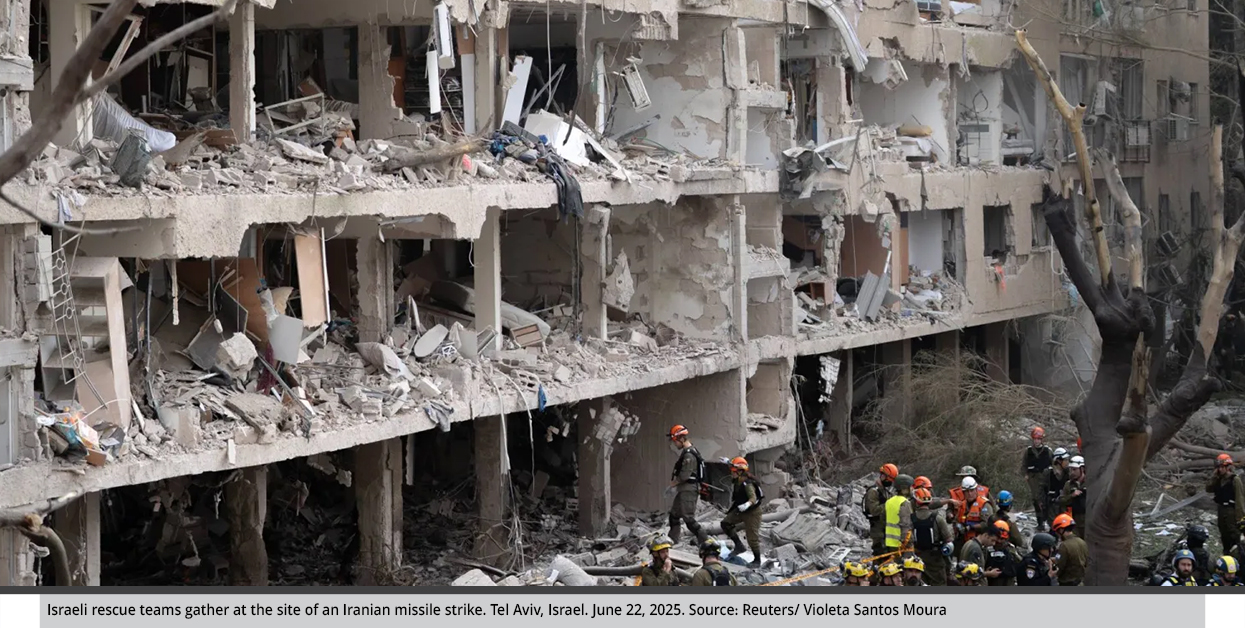Scenarios for the Next Step Following U.S. Strikes on Iranian Nuclear Facilities
The regional balance of power shifted with the direct entry of the United States into the military confrontation with Iran when it launched a precision airstrike on June 22, 2025 that targeted key nuclear installations. It pushes Iran to a critical crossroads: either contain the escalation or move toward a full-scale confrontation amid rising regional tensions and growing fears of a multi-front war.
by STRATEGIECS Team
- Release Date – Jun 22, 2025

The United States has entered the ongoing Israeli military operations against Iran’s strategic capabilities in an unprecedented and significant escalation. On June 22, 2025, Washington carried out a military strike targeting three major Iranian nuclear facilities: Fordow, Natanz, and Isfahan. The operation was conducted using long-range American B-2 stealth bombers and high-precision Tomahawk missiles.
U.S. President Donald Trump announced that the strike using bunker-buster bombs had completely destroyed Iran’s fortified enrichment sites, particularly the Fordow facility located in a heavily fortified mountainous area near the city of Qom.
This strike came in the context of ongoing Israeli-Iranian hostilities since June 13 and now stands as the most escalatory act against Iran to date, raising serious regional and international concerns about the next phase of escalation. Iran has vowed to respond, potentially by targeting U.S. military bases and interests across the Middle East, a scenario that could drag the region into a multi-front war.
Accumulated Indicators and Preparatory Developments
The U.S. strike on Iranian nuclear facilities came as an expected development within the broader trajectory of Israel’s ongoing military campaign against Iran’s strategic capabilities. That campaign began with targeted assassinations of Islamic Revolutionary Guard Corps (IRGC) commanders and nuclear scientists, and later expanded to include Iran’s missile forces and air defense systems.
The scope of operations during the first week initially focused on northern Iran before progressing toward the central regions—particularly Isfahan—with expectations that it may soon extend to the country’s eastern and southern regions.
The American strike marks a decisive turning point in the course of the “semi-direct” negotiations between the United States and Iran, which began their first round on April 12 this year. Talks continued until the sixth round was postponed following the Israeli strikes. Signs of a potential resumption appeared on June 21 through a European-mediated round of negotiations involving Iranian representatives and delegates from the UK, France, and Germany. However, the meeting failed to produce any agreements or achieve a meaningful political breakthrough in the nuclear file.
Signs of the impending U.S. strike became increasingly evident as Washington intensified its unprecedented military buildup in the region, particularly with long-range strategic bombers. This included airstrikes against the Houthis in Yemen in March 2025 that were seen as the operational opening of a new phase in the conflict with Iran.
As preparations for the strike advanced, U.S. forces heightened their readiness by deploying more B-2 and B-52 strategic bombers to its Diego Garcia air base in the Indian Ocean. This was followed by the aircraft carrier USS Nimitz moving from the South China Sea to the Arabian Sea. Several key U.S. military bases under the U.S. Central Command Coalition increased its alert status, bolstering defensive capabilities.
Simultaneously, reports emerged of partial evacuations of non-essential personnel from certain U.S. military and diplomatic sites in anticipation of possible Iranian retaliatory attacks—an unmistakable field indicator of an imminent and strategically significant confrontation.
These military maneuvers coincided with an escalation in U.S. political rhetoric against Iran’s nuclear program, preparing domestic and global public opinion for the likelihood of military action. For instance, On June 19, U.S. President Donald Trump declared that Iran was just steps away from producing a nuclear weapon, warning that time was running out and that he would decide in two weeks whether to take decisive military measures against Iran.

Divergence in Statements Regarding the Damage
The discourse following the U.S. strike focused heavily on its results and expected impact. Trump described the operation as “highly successful,” asserting the complete destruction of the three targeted nuclear facilities. And U.S. Joint Chiefs of Staff Chairman General Dan Caine stated that initial assessments showed significant damage to the Iranian sites.
On the other hand, Iran acknowledged the attacks but downplayed the extent of their damage, especially to the Fordow Uranium Enrichment Plant. An advisor to the speaker of the Iranian Parliament claimed that the sites had been evacuated long ago and downplayed the damage as “repairable,” denying that it reached the level of catastrophic loss.
It is clear that this divergence in claims regarding the extent of the damage stems from a fundamental difference in assessment methodology. The United States focuses on the direct targeting of Iran’s fortified nuclear infrastructure itself, which is highly likely to have sustained severe damage due to the use of powerful GBU-57 “bunker buster” bombs. Each bomb weighs 13,500 kilograms (30,000 pounds) and can penetrate through approximately 60 meters (200 feet) of reinforced concrete before exploding.
Theoretically, dropping successive bombs allows for deeper penetration into the facility, effectively drilling deeper and deeper with each successive blast. Reports indicate that the United States used six bombs in its strike on the Fordow site, with a total estimated weight of around 81,000 kilograms (17,800 pounds). This strongly suggests that the bombs reached deep into the fortified underground facility—or, at the very least, caused enough cumulative destruction above the reactor’s physical and technical infrastructure to render it damaged and potentially inaccessible.
From this perspective, Iran’s denial of major damage may not be accurate, especially since the facility was designed to withstand conventional bombs, not advanced bunker busters. However, confirming the actual extent of the damage would require a full-scale and complex debris removal operation to access the deep underground sections. This process could take weeks or even months to complete.
Conversely, Iran appears to base its public assessment on different factors: primarily its nuclear assets, including its stockpile of enriched and highly enriched uranium, and possibly its more advanced IR-6 centrifuges. Tehran announced that it had evacuated sensitive materials from the three targeted nuclear sites before the strike, in a clear effort to minimize strategic losses and reduce the risk of direct nuclear fallout.
Supporting this claim, satellite imagery and reports published after the strikes reveal unusually heavy truck activity around the Fordow facility two days before the U.S. strike, indicating a possible transfer of highly enriched uranium. This likely contributed to averting a radiological and environmental disaster that could have had cross-border consequences. Both Iran and Saudi Arabia, along with the International Atomic Energy Agency, confirmed that no radiation spike was recorded following the attack.
This raises the possibility that a U.S. security warning was sent to Iran to prevent radioactive contamination via an indirect or undeclared intelligence or diplomatic channel between the two sides. This would support the theory that Washington intended to send a calculated and decisive deterrent message while deliberately avoiding a humanitarian catastrophe.

A Critical Crossroad for Iran
The recent U.S. military operation places Iran at a critical crossroad between two main options. The first is to gradually de-escalate the situation on the ground to avoid an all-out escalation that could threaten the stability—and even the survival—of the Islamic Republic of Iran regime. Tehran now recognizes that it has lost the ability to deter or deliver a proportional response to the scale of the attacks. This is due both to operational limitations following the erosion of its regional proxy network, especially Hezbollah in Lebanon, and to the Houthi-U.S. agreement signed in March 2025 that resulted in a mutual cessation of attacks.
Furthermore, Iran’s limited response to the Israeli strikes on its territory, despite unveiling advanced missiles capable of penetrating defense systems, failed to achieve meaningful strategic deterrence. Meanwhile, Israel continued to execute its operations with precision against its preselected target bank, effectively paving the way for direct U.S. intervention through strikes on Iran’s nuclear facilities.
The second option involves Iran moving toward escalation, based on two possible scenarios depending on the prioritization of its internal considerations: either by separating the American strikes from the primary confrontation framework with Israel or by responding on the basis that the American and Israeli attacks constitute a single front of aggression against it.
Scenario One: Separating U.S. Strikes from the Core Confrontation with Israel
In this scenario Iran’s response to the U.S. attacks would be isolated from its ongoing confrontation with Israel. In this case, Iran is likely to carry out limited or symbolic strikes against American military bases or interests that would not provoke a broader U.S. military engagement. Such a move would mirror Iran’s retaliatory approach in 2020 following the U.S. assassination of Quds Force commander Qassem Soleimani when Tehran targeted the Al-Asad Airbase housing U.S. troops in northern Iraq.
This makes it likely that Iran will avoid targeting U.S. bases across the region, particularly those located in Arab countries with which Tehran is trying to maintain diplomatic ties amid ongoing de-escalation efforts and mediation initiatives. Accordingly, Iran’s retaliatory options against U.S. forces may focus on targets in Iraq and Syria that are less likely to trigger a wide-scale regional response or it could potentially target U.S. forces operating under the U.S. Africa Command, thereby avoiding direct escalation in the Middle East.
Iran may also resort to threatening international trade in the Strait of Hormuz by targeting or seizing vessels linked to the United States. However, it is unlikely to disrupt navigation in the strait entirely, as such a move could alienate its strategic partners, foremost among them China, due to the global economic fallout of a full blockade.
In this scenario, the Iranian-Israeli confrontation may continue independent of the limited U.S. intervention, which has so far focused solely on targeting nuclear facilities. Iran is likely to maintain its current military tactic of disrupting Israel’s escalation momentum. In fact, on the same morning as the U.S. strikes, Iran launched a 40-missile attack on northern and central Israel as part of the 20th wave of its “Operation True Promise 3.”
However, the American strikes may push Tehran to intensify its military pressure on Israel, either by carrying out more precise and impactful attacks or by incorporating advanced missile systems into future operations. The latest attack already revealed a qualitative shift in this direction, with Iran using its Kheibar long-range ballistic missile for the first time—a missile equipped with a two-ton warhead and notable for its high maneuverability.
This approach is aimed at avoiding the consequences of dragging the full weight of the United States into Israel’s military operations against Iran. Its attractiveness is further reinforced by the fact that, at this complex and sensitive juncture, preserving the security and survival of the Iranian regime—as well as national security more broadly—has become a higher strategic priority than engaging in open-ended escalation. Such escalation could potentially lead to an expansion of Israeli and American objectives toward regime change or the systematic erosion of Tehran’s internal control through continued targeting of national Iranian interests.

On the other hand, Iran continues to keep the door open—within its strategic calculations—for the possibility of resuming negotiations with the United States regarding the remaining nuclear assets it still preserves, chief among them its stockpile of enriched uranium. One potential track involves negotiating the transfer of this stockpile to a third country, as proposed in the Witkoff Plan—a proposal Tehran rejected during the latest round of talks with Washington. Another option would allow the nuclear program to remain on Iranian soil but under direct oversight by a third-party monitor, possibly European. This approach would aim to preserve a minimal level of gains within the peaceful threshold (3.76% enrichment).
Scenario Two: Responding to U.S. and Israeli Strikes as a Unified Front
If Iran interprets the American and Israeli strikes as a single front of aggression, it will likely declare a state of war and national emergency that would involve potentially imposing martial law and mobilizing the country’s full resources and manpower for military purposes. Such a step would reflect Iran’s perception that Israel’s military operations, especially their continuation after the U.S. strike, is an expansion of strategic goals beyond merely dismantling the nuclear program but toward undermining the regime’s ability to maintain internal cohesion.
This escalation comes at a time when Iran is grappling with significant internal security breaches that have facilitated Israeli strikes deep inside its territory, including its assassination of many high-ranking Iranian military leaders. There are also growing fears in Tehran that these breaches may extend into the country’s political infrastructure. From this perspective, Iran may view the American and Israeli objectives as integrated, with both nations aiming to paralyze the regime’s military, nuclear, and security capabilities.
In this scenario, Iran may take escalatory measures that include launching military strikes against American bases in the region, such as those in the Gulf countries, or involving its regional proxies, especially those that have managed to relatively maintain their strength, such as the Houthis in Yemen and armed factions in Iraq that operate near the American military presence.
Other options include closing the Strait of Hormuz to disrupt navigation or rendering it unnavigable by planting thousands of explosive naval mines that can take several years to clear. This would lead to a complete disruption of trade movement through the strait that accounts for more than 20% of the daily global total of sea-transported oil and gas trade and 22% of essential strategic goods. Indeed, the Iranian Parliament has already approved closing the Strait of Hormuz following the American strikes. However, the final decision to execute this is contingent upon the approval of the Iran’s Supreme National Security Council.
Within this scenario, it is expected that Iran would also direct strategic and qualitative strikes against energy and petrochemical targets directly against Israel and indirectly against Western and Arab interests related to energy facilities in Israel.
Finally, Iran’s options and possible response scenarios carry a series of implications that threaten the stability of its political system. Containing the American strike without a reciprocal response could expose the regime to a critical wave of domestic accountability, weakening its position against opponents and critics who may perceive it as incapable of defending Iran’s national sovereignty. On the other hand, moving towards full-scale escalation carries greater strategic risks, foremost among them the possibility of expanded American military intervention inside Iran, which could lead to an existential threat to the regime.
In either case, the Iranian political system appears to be going through one of its most critical moments since the founding of the Islamic Republic, which must now find a fragile balance between deterrence and vulnerability and between survival and forced change.

STRATEGIECS Team
Policy Analysis Team
 العربية
العربية